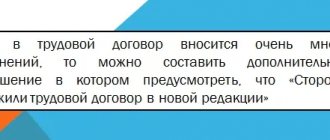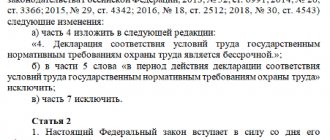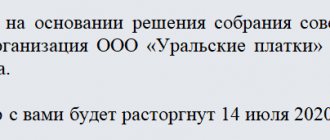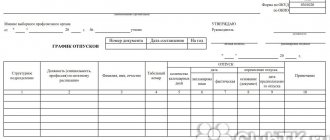Why is SOUT carried out?
A special assessment of working conditions is a set of actions aimed at identifying the presence or absence of factors affecting the health of an employee. The procedure was introduced by the government in 2014 as an alternative to certification, and is governed by Russian Federation Law No. 426FZ dated December 28, 2013.
The SOUTH identifies violations in the field of labor protection in cases where the employer conceals reliable information about the state of the workplace, saves on payments and benefits to the employee corresponding to the hazard classes. Thus, the state expresses concern for working people.
The procedure is carried out every five years. To conduct this, a special commission is created, which consists of the head of the company or an employee authorized for occupational safety, a member of a trade union organization represented by an employee and an expert from a special organization authorized to carry out special labor safety measures. To conduct an inspection, an order or instruction is issued; based on the results of the inspection, a declaration is filled out and the data is transferred to the Ministry of Labor.
After 5 years, the inspection period is automatically extended for the same period if:
- there were no changes at the enterprise in terms of the construction of the technical process;
- it was not planned to modernize equipment and purchase new and improved equipment;
- no accidents were recorded.
Having summed up the results of the inspection, the employer introduces them to employees against signature within 30 days.
If the inspection is not carried out on time, or the procedure for carrying out the special inspection system is violated, then the enterprise is obliged to pay a fine in accordance with the Code of Administrative Offenses 5.27.1 of the Code of Administrative Offences.
Classes of working conditions, according to the Labor Code, are determined depending on the impact on the employee’s health:
- 1st class, optimal. There are no conditions that would negatively affect the health of the employee.
- Class 2, acceptable. Negative working conditions are present, within acceptable standards, but require the use of protective equipment (glasses, helmets, special shoes, etc.). A night's rest or between shifts is enough to restore the body's performance.
- Class 3 and its subclasses from 3.1-3.4, harmful. Unfavorable health conditions are present at elevated rates. The group is divided into categories depending on the severity of the impact on the employee’s health.
The range of work is wide:
- with toxic substances (paint, solvents, etc.);
- with welding;
- in a dusty room;
- in conditions of increased noise, pressure, vibration;
- requiring high physical activity, traumatic;
- in unfavorable atmosphere conditions (presence of viruses, pathogenic bacteria.
Class 4, dangerous. There are dangerous factors that lead to the development of serious diseases. This is work with radioactive substances and chemicals. This class is rare.
According to the Labor Code, in the third and fourth classes, full or partial payments and benefits are provided in the form of:
- salary allowances (Article 147);
- additional days of vacation (Article 117);
- reduction of hours of the working week (Article 92);
- other types of benefits (special food, paid treatment, early retirement).
When changes are made to an employment contract
Upon employment, the employer and the employee enter into an employment contract. The data entered into the document is regulated by Article 57 of the Labor Code of the Russian Federation. Information about working conditions and appropriate compensation, if any are provided for by the hazard class, is also required.
During the validity period, changes may be made to the contract by issuing additional documents. agreements.
When adjusting the conditions identified during the examination, mandatory amendments must be made to the employment contract based on the results of the special assessment, through the signing of an additional agreement. agreements.
Drawing up an additional agreement to the employment contract
Typically, the responsibility for drawing up additional agreements to employment contracts lies either with the organization’s legal adviser or with a specialist/head of the human resources department. In any case, this must be an employee who has an idea of how to draw up documents of this kind and is well acquainted with the civil and labor legislation of the Russian Federation.
If the employing organization uses stamps in its work to endorse documentation, then the agreement form must be stamped. The document must be prepared in two identical copies - one of them remains with the employer, the second is given to the employee.
Cancellation of benefits
It is carried out if the working conditions are harmful or dangerous and are found to be acceptable or optimal during inspection (Article 74 of the Labor Code of the Russian Federation). This is possible if the workplace is modernized, new modern equipment is purchased, and additional equipment is installed. cleaning, filters, etc.
Two months before the end of accrual of benefits, the employee is notified of this by a written notice drawn up in any form, certified by the signature of the general director of the organization.
If the employee is not satisfied with this fact, in this case the employer may offer another job, if available. Or the employment contract is terminated by voluntary consent of the parties.
The employee is also authorized to appeal these special assessments and decisions on the state of working conditions in court, or contact the Ministry of Labor with a request for a re-assessment.
According to Law No. 421-FZ, payments and benefits have undergone changes compared to the certification carried out before October 1, 2014.
For example, subclasses 3.1 and 3.2 abolish the right to a shortened working week. For subclass 3.1, additional vacation days are canceled.
But if, based on the results of the special labor assessment, working conditions have not changed since then, and no improvements have been introduced in the workplace, then the compensation is retained.
How to correctly make changes to an employment contract
According to Part 2 of Art. 57 of the Labor Code of the Russian Federation, when applying for a job, the employment contract specifies in detail the working conditions and compensation corresponding to the class of compensation.
If an employee gets a job at a newly opened workplace that has not yet passed the SOUT, then describe the general data about the work area, Art. 2. 17 of Law No. 426-FZ. For example, the office number, the location of the workplace relative to the walls, what is equipped, what devices and protective equipment are used, etc.
After carrying out the SOUT, an additional document is issued. agreement detailing the results of the audit. The document is recognized as part of the employment contract, and if agreed, it is signed by both parties. If the employee does not agree, he can make amendments and send them to management for review. The employer is obliged to provide feedback on them within thirty days.
If both parties disagree or there is no feedback from the manager, the resolution of the dispute may be referred to the court.
The absence of data on the class of conditions in the employment agreement, after the SOUT, is considered a violation of the Labor Code and the law on SOUT. For this, the employer must pay a fine.
Additional agreement to the employment contract: samples
The supplementary agreement is an integral part of the employment contract. Therefore, the additional agreement must be drawn up in two copies: one for the employee, the other for the employer. If the organization keeps a journal of additional agreements to employment contracts, then make an entry in it about issuing the employee a copy of the additional agreement. Also see “Logs of registration of employment contracts and additional agreements”. It is not at all necessary that the employee signs in this journal. After all, his signature will already be on the supplementary agreement itself.
Read the above articles if you need to enter into an additional agreement in the listed cases. They all describe in some detail what the employer needs to do and within what time frame. If we are talking about general cases of concluding additional agreements, then we suggest that you familiarize yourself with the samples.
Sample additional agreement based on the results of the special assessment
Lastly, about extras. agreement to the employment contract based on the results of the special labor assessment - the sample is not provided for by law, a free form is acceptable, with the entry of mandatory data.
- information regarding which number of the employment contract the agreement is drawn up;
- Full name of the employer and employee indicating their positions;
- Text of amendments made to the agreement;
- Effective date;
- details and signatures.
This is important to know: Notice of termination (termination) of an employment contract
Sample additional agreement to an employment contract
The employer has the right to revise employee salaries, increasing them by the percentage of inflation, additional payments to the minimum wage, or establishing its own indexation standards. Such changes are the basis for drawing up an additional agreement. Employee familiarization is mandatory.
The text must indicate the clause of the employment contract containing the employee’s position and its presentation in the new edition. The position to which he is transferred and the date from which this change will take effect are indicated.
What to do if a special assessment reveals harmful working conditions?
Author: V. P. Yushchin
What should an employer do if, in workplaces with normal working conditions, a special assessment reveals the presence of harmful factors and, according to the conclusion of the commission, they are assigned a hazard class? Is it necessary to notify employees about this and make changes to the employment contract? From what point on should guarantees and compensations provided under the Labor Code of the Russian Federation be provided to employees whose working conditions have deteriorated?
The company, in accordance with legal requirements, conducts a special assessment. As a result, in some workplaces, working conditions are assigned a hazard class, for example 3.1 or 3.2. At the same time, working conditions were normal before. What should an employer do in such a situation? Is it necessary to amend the employment contract and include information about harmful conditions in the workplace? How to provide guarantees and compensation to workers whose working conditions have deteriorated? From when should I do this? Yes, there are a lot of questions. First things first.
A few words about special assessment.
By virtue of Art. 212 of the Labor Code of the Russian Federation, the responsibility for ensuring safe conditions and labor protection rests with the employer. For these purposes, the employer is obliged to ensure, among other activities, a special assessment of working conditions in accordance with Federal Law No. 426-FZ of December 28, 2013 “On Special Assessment of Working Conditions” (hereinafter referred to as Law No. 426-FZ).
The meaning of a special assessment is that the employer, through an invited independent specialized organization, analyzes the state of working conditions at predetermined workplaces. This is done for:
- identification of harmful and (or) hazardous production factors;
- assessing the level of impact of such factors on the employee;
- determining the degree of deviation of the obtained values from the established standards;
- assessing the effectiveness of the use of personal and collective protective equipment for workers.
What working conditions are considered safe is stated in Art. 209 of the Labor Code of the Russian Federation: conditions under which exposure to harmful and (or) hazardous production factors on workers is excluded or exposure levels do not exceed established standards.
Exposure to a harmful factor can lead to illness in an employee, and exposure to a dangerous factor can lead to injury. If such conditions are identified during a special assessment of the workplace, the working conditions are assigned a class (subclass) of hazard and (or) danger. There are only four classes - optimal, permissible, harmful and dangerous conditions (Part 1 of Article 14 of Law No. 426-FZ). At the same time, hazardous working conditions have four subclasses (degrees).
Note that the class (subclass) of working conditions established at the workplace depends on:
- provision of guarantees and compensation to employees (additional leave, reduced working hours, increased wages);
- the amount of the additional insurance premium rate (the better the working conditions, the lower the amount of deductions).
The results of the special assessment do not affect the rate of contributions in case of injury. The tariff is set by the Social Insurance Fund based on data on the main type of economic activity of the company for the previous year (Rules for classifying types of economic activity as professional risk, approved by Decree of the Government of the Russian Federation of December 1, 2005 No. 713).
Maintaining working conditions in an optimal or acceptable state allows the employer to reduce costs, because there will be no need to make payments to employees and tax deductions.
Meanwhile, there are often situations when the employer does not care about working conditions, does not modernize production - and as a result, even in workplaces where there were normal working conditions, they become harmful or dangerous.
Special assessment of working conditions additional agreements
If the working conditions established during the special assessment process change, amendments must be made to the employment contract.
This is formalized by drawing up an additional agreement. From this article you will learn: • when it is necessary to draw up an additional agreement regarding changes in working conditions; • how to draw up an additional agreement based on the results of a special assessment of working conditions; • sample additional agreement based on the results of a special assessment of working conditions. 14 of Law No. 426-FZ). In total, four classes of working conditions are identified:
- Class 2 – acceptable;
- Class 3 (subclasses 3.1, 3.2, 3.3, 3.4) – harmful;
- 1st class – optimal;
- Class 4 – dangerous.
If they are recognized as dangerous or harmful, then the contract additionally specifies guarantees on the part of the employer, designed to compensate for work in unsafe conditions.
When hiring an employee, the employment contract establishes working conditions with a definition of class, in accordance with the system adopted by law (Art.
In cases where the working conditions were initially found to be safe, and during a special assessment risk factors or threats to the employee’s health were identified, changes must be made to the employment contract.
A special assessment of working conditions, as a result of which additional agreements are included in the employment contract, is carried out in accordance with Federal Law No. 426-FZ “On the Special Assessment of Working Conditions”, which came into force on January 1, 2014. On the basis of this regulatory act, changes were made to certain legislative acts, which is recorded by Federal Law No. 421-FZ, which legislatively approved all changes and amendments related to the law on special assessment.
Depending on the results of the work carried out in the organization, it may be necessary to draw up additional agreements.
Based on Part 2 of Article 57 of the Labor Code of the Russian Federation, when drawing up an Employment contract with an employee, the document indicates the category (class/subclass) of working conditions. Such conditions are determined for each individual division and structure of an organization or enterprise and are determined by the parameters of the workplace and the nature of the work for each position.
All employees must be notified of the results of the special assessment within 30 days. An additional agreement is a document by which changes are made to the employment contract with an employee. This document is drawn up when, based on the results of a special assessment, working conditions in the workplace have changed.
Valid options:
- In the employment contract with the employee, working conditions are specified as optimal or acceptable, which is documented by the results of workplace certification. During the special assessment, the category of working conditions changed - they were recognized as harmful and dangerous. Based on the results of the inspection, an additional agreement is drawn up.
- Initially, the working conditions at the employee’s workplace were recognized as dangerous or harmful, but as a result of a special assessment, their characteristics changed for the better. The recognition of working conditions as optimal and acceptable is also indicated in the additional agreement.
Guarantees and compensation for work in hazardous conditions.
Work time.
According to Art. 92 of the Labor Code of the Russian Federation for workers whose working conditions at their workplaces, based on the results of a special assessment, are classified as hazardous of the 3rd or 4th degree or dangerous, are guaranteed a shortened working week - no more than 36 hours. In this case, the working hours of a particular employee are established by an employment contract on the basis of an industry (inter-industry) agreement and a collective agreement, taking into account the results of a special assessment of working conditions.
On the basis of an industry (inter-industry) agreement and a collective agreement, as well as the written consent of the employee, formalized by concluding a separate agreement to the employment contract, the said working hours can be increased, but not more than up to 40 hours per week with payment to the employee of a separately established monetary compensation in the manner, amount and on the terms provided for by industry (inter-industry) agreements and collective agreements.
Additional vacation.
In accordance with Art. 117 of the Labor Code of the Russian Federation provides annual additional paid leave to employees whose working conditions at their workplaces, based on the results of a special assessment, are classified as:
- to harmful 2nd, 3rd or 4th degree;
- to dangerous.
As we can see, this guarantee is provided to a wider range of employees.
The minimum duration of the said leave is 7 calendar days and is established by the employment contract on the basis of an industry (inter-industry) agreement and a collective agreement, taking into account the results of a special assessment.
On the basis of an industry (inter-industry) agreement and collective agreements, as well as the written consent of the employee, formalized by concluding a separate agreement to the employment contract, part of the annual additional paid leave that exceeds 7 calendar days can be replaced by a separately established monetary compensation in the order, in the amounts and on the terms determined by the industry (inter-industry) agreement and collective agreements.
Increased wages.
This guarantee is provided to all employees whose working conditions are recognized as harmful or dangerous, regardless of the class of hazard. In particular, by virtue of Art. 147 of the Labor Code of the Russian Federation, remuneration for workers engaged in work with harmful and (or) dangerous working conditions is established at an increased rate. The minimum increase is 4% of the tariff rate (salary) established for various types of work with normal working conditions. The specific amounts of wage increases are determined by the employer, taking into account the opinion of the representative body of employees in the manner prescribed by Art. 372 of the Labor Code of the Russian Federation for the adoption of local regulations, or a collective or labor agreement.
What about employees?
So, if, based on the results of a special assessment, harmful production factors were identified at some workplaces and a hazard class was established, it is necessary for workers to be provided with the guarantees provided for by the Labor Code of the Russian Federation (see diagram).
This is important to know: Employment contract with a disabled person of group 3 (sample)
Guarantees provided to employees depending on the hazard class
Salary increase of at least 4%
Increase in salary by at least 4%, provision of at least 7 days of additional leave
Increase in salary by no less than 4%, provision of at least 7 days of additional leave, establishment of reduced working hours (no more than 36 hours per week)
Question:
Professions and jobs in which harmful working conditions were identified during a special assessment are not included in the “harmful” lists. What to look for when determining the amount of guarantees?
Currently still in effect:
1. Lists of industries, works, professions, positions and indicators that give the right to preferential pension provision (approved by Resolution of the Cabinet of Ministers of the USSR dated January 26, 1991 No. 10).
2. Lists of industries, workshops, professions and positions with hazardous working conditions, work in which gives the right to additional leave and a shortened working day (approved by the Resolution of the State Committee for Labor of the USSR, the Presidium of the All-Union Central Council of Trade Unions dated October 25, 1974 No. 298/P-22).
These lists are applied to the extent that they do not contradict the Labor Code. According to the latter, the employer is obliged to provide guarantees and compensation if working conditions are considered harmful or dangerous. Moreover, the code does not oblige one to be guided by these lists. If professions, positions or types of work where working conditions are recognized as harmful are not indicated in these lists, such workers are still entitled to guarantees and compensation. When establishing them, one must be guided by Art. 92, 117 and 147 of the Labor Code of the Russian Federation.
What documents should I submit?
In order for employees to receive guarantees and compensation, a number of documents must be completed.
Firstly, it is necessary to familiarize employees with the results of the special assessment at their workplaces against signature within 30 calendar days from the date of approval of the report on the special assessment (Part 5, Article 15 of Law No. 426-FZ).
Secondly, an order is issued by the organization to establish salary bonuses, additional paid leave, etc. Let’s give an example.
Limited Liability Company "Rubin"
on establishing a wage premium and additional paid leave for hazardous working conditions
N. Novgorod April 12, 2021
In connection with the identification of harmful conditions of class 3.2 based on the results of a special assessment of the janitor’s workplace in terms of working conditions
1. Assign an additional payment to employees working as janitors in the amount of 4% of the salary accrued for the time worked.
2. Establish additional annual paid leave for janitors of 8 calendar days.
3. Accountant G. D. Ogrankina, from April 12, 2017, to calculate the wages of janitors, taking into account additional payments for work in hazardous working conditions.
Reason: report on a special assessment of working conditions dated 04/12/2017.
Director Karatov E.P. Karatov
I have read the order:
Accountant Ogrankina, 04/12/2017
Question:
Is it necessary to draw up an additional agreement to the employment contract after carrying out the special labor assessment?
9.3. To the head of the labor protection service: - ensure the storage of documentation based on the results of a special assessment of workplaces based on working conditions; — inform newly hired employees about working conditions in the workplace, about the existing risk of damage to their health, about measures to protect against the effects of harmful and (or) hazardous production factors during induction training against signature.
1. Consider the work and materials for the special assessment of working conditions of 61 workplaces completed. 2. Approve the report on the special assessment of working conditions. 3. Within three working days from the date of approval of the report on the special assessment of working conditions, send a letter with a scanned copy of the title page of the report to the Contractor’s email, and also send to the Contractor a copy of the approved report on the conduct of special labor conditions by registered mail with notification of delivery, or in the form of an electronic document signed with a qualified electronic signature. 4. Within 30 calendar days from the date of approval of the report on the special assessment of working conditions, organize familiarization of workers with the results of the special assessment of working conditions. 5. Based on the results of a special assessment of working conditions, within 30 calendar days from the date of approval of the report, develop a list of measures to improve working conditions and labor protection of workers (if necessary). 6. Within 30 working days from the date of approval of the report on a special assessment of working conditions, draw up and send a Declaration of compliance of working conditions with state regulatory requirements for labor protection to the State Labor Inspectorate at the place of its location in relation to workplaces where working conditions are recognized as optimal or acceptable , with the exception of workplaces specified in Part 6 of Article 10 of the Federal Law on SOUT No. 426-FZ, as well as in relation to workplaces in which harmful and (or) hazardous production factors have not been identified as a result of identification. 7. Based on the results of a special assessment of working conditions, by October 18, 2021, prepare proposals (if necessary) for making changes and (or) additions to the employment contract regarding the employer’s obligation to provide the employee with PPE, establishing an appropriate work and rest regime, as well as others guarantees and compensation established by law for work under harmful and (or) dangerous working conditions.
We recommend reading: Benefits for honorary donors of the Tyumen region in 2021











